
Denmark - Diesel locomotives and diesel multiple units of DSB
For a full scale picture, please click on the picture shown !
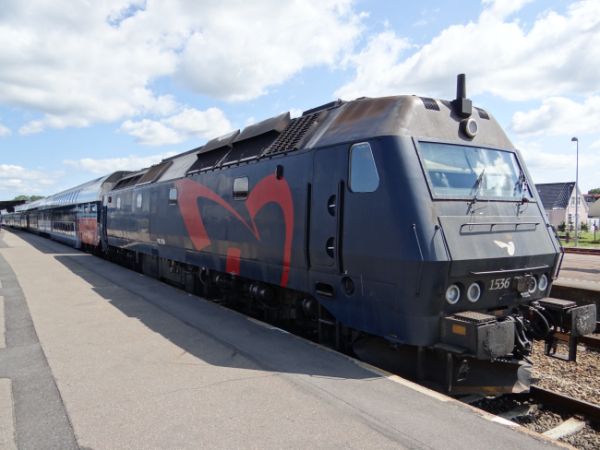
Denmark is still largely a diesel country. These huge
six axle diesels of the class ME were delivered by Henschel beginning 1981 already. There were many problems with them
initially, but now they operate quite well, despite their age. This type of class ME driven double decker
trains are especially common around København/Copenhagen.
Picture from Nykøbing 11.7.2013 by Ilkka Siissalo.
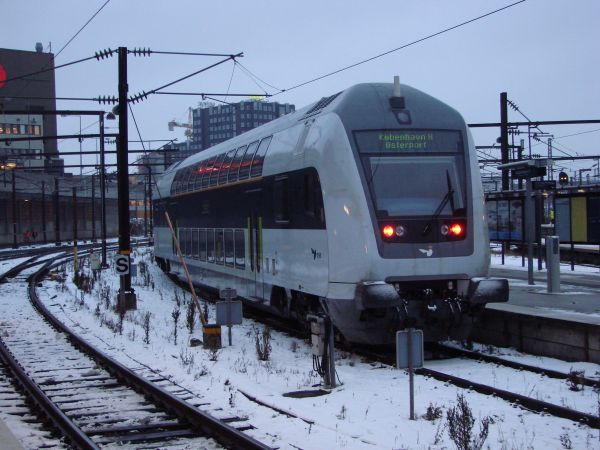
Today the class ME diesels typically haul push-pull double decker coach trains where the coaches are made by
Bombardier and are essentially identical to those used in Germany. This is the steering wagon found
at the other end of each such train.
Picture at København C 12.1.2010 by Ilkka Siissalo.
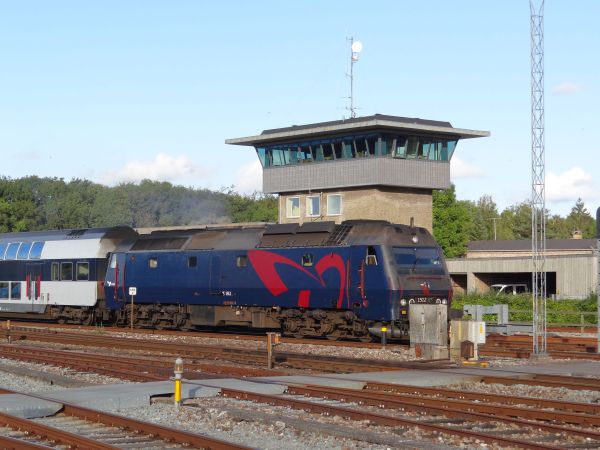
One of the huge class ME diesels with a rake of Bombardier built doubledecker coaches is arriving from København
to Nykøbing.
Photo from Nykøbing (Falster) station 21.9.2014 by Ilkka Siissalo.
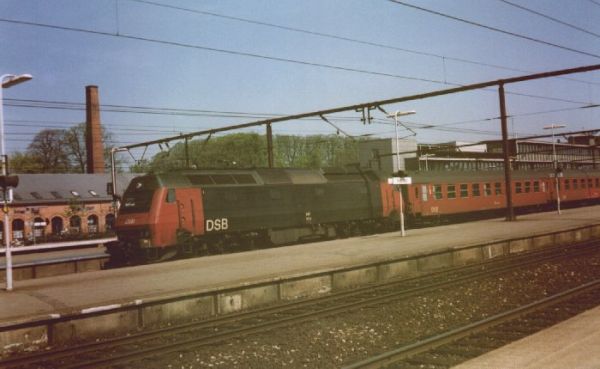
This is how the class ME looked like originally. DSB ME 1514 at Roskilde Station, first part of May 1996.
Photo and scan by Joac. joachiml-at-geo.ruc.dk
Uploaded Jan 31, 1998.

Danish diesel locomotive ME 1528 at Nykøbing Falster station.
August 1996. Picture by Thomas Soerensen.
Uploaded Dec 20, 1996.
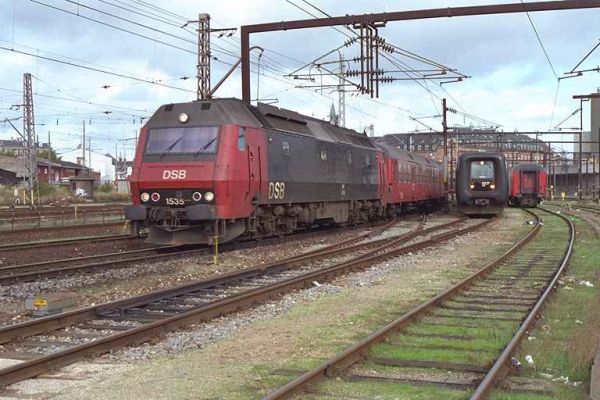
DSB ME 1535 Co'Co' locomotive GM 645E3B-16 built in 1985. Picture at København/Copenhagen Central
station on 13 October 1995 by Erik Hjelme.
Uploaded Nov 18 1995
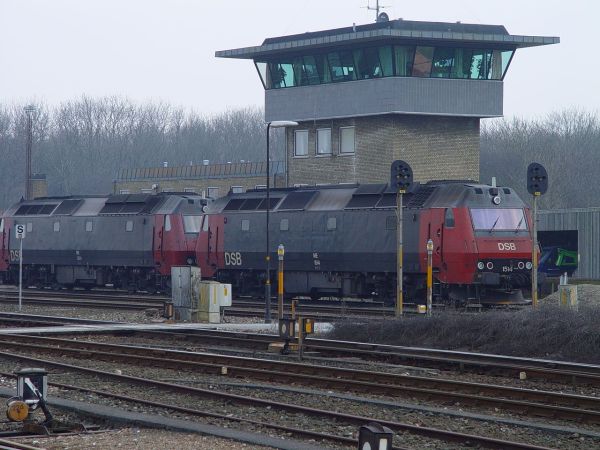
In 2003 some of the class ME diesels were still to be seen in their original black and red colours.
Picture from Nykøbing (Falster) station 2.3.2003 by Ilkka Siissalo.
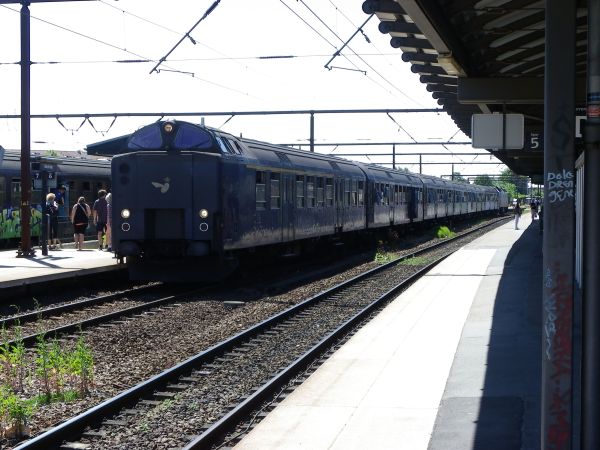
Before DSB bought modern and comfortable doubledecker coaches from Bombardier for the Copenhagen area commuter
traffic, a typical commuter train looked like this: Old 1970s coaches together with an ugly steering wagon hung
behind a huge class ME diesel.
This picture is from 2010 when these compositions were no longer in regular use, but the picture is from Roskilde
station during the time when the famous Roskilde rock festival was taking place. Many of the rock festival visitors
were dead drunk and not so tidy, so DSB used old rolling stock to haul them from the airport and harbour to
Roskilde.
Picture from Roskilde station 1.7.2010 by Ilkka Siissalo.
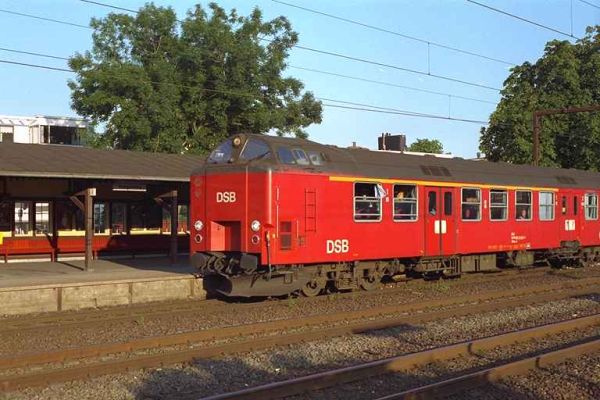
This is how the same DSB ADns-e steering wagons used to look like originally.
Built in the seventies and rebuilt several times since,
these coaches offered both a 1st class compartment and
a flex compartment for bicycles and prams. Both diesel
and electric locomotives could be controlled from the
driving cab.
Photo from Klampenborg, Denmark 17 August 1995 by Erik Hjelme.
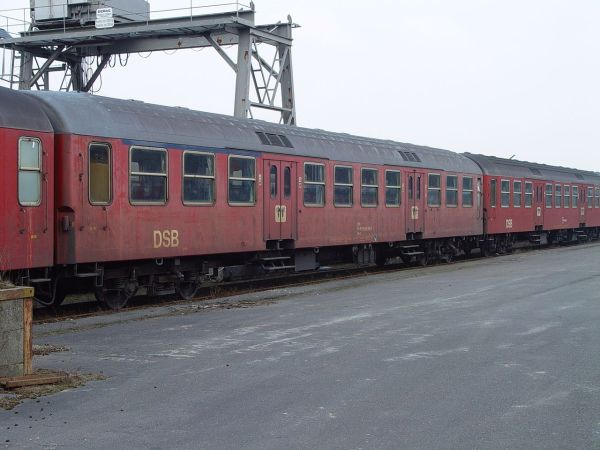
And this is how the old wagons that were typically used with the ADns-e steering wagons looked like still in their
original red livery in 2003. They closely resemble German so called "Silberling" wagons of 1960s. This kind of
trains together with the huge class ME diesels shown above were still the typical Danish regional trains in the beginning
of the 2000s.
Picture from Nykøbing (Falster) station 2.3.2003 by Ilkka Siissalo.
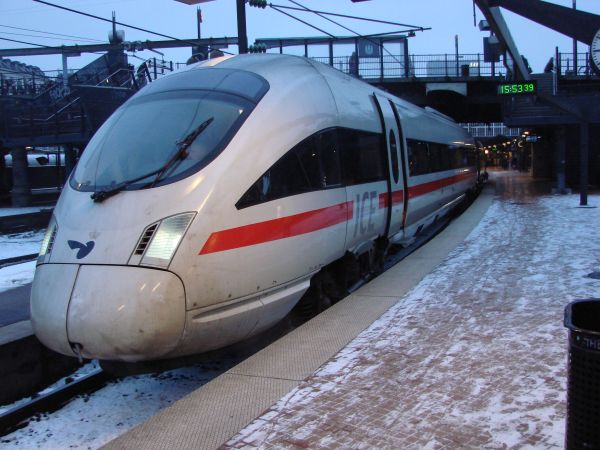
As the Italian built AnsaldoBreda IC4 trains turned out to be a full Italian fiasco, DSB had to quickly get
trains from somewhere and rented from the German DB their fleet of the diesel ICE trains of class 605, also known as
ICE-TD. The trains' active tilting technology was turned off and they were fitted with Danish security systems,
but the maintenance of the trains remained with DB. In 2019 however DSB returned all these trains to DB and DB started
scrapping all these quite modern trains as it is a very small class of trains and maintenance of the ageing trains
is becoming excessively more difficult.
Picture of an ICE-TD with DSB stickers 12.1.2010 at Copenhagen central station by Ilkka Siissalo.
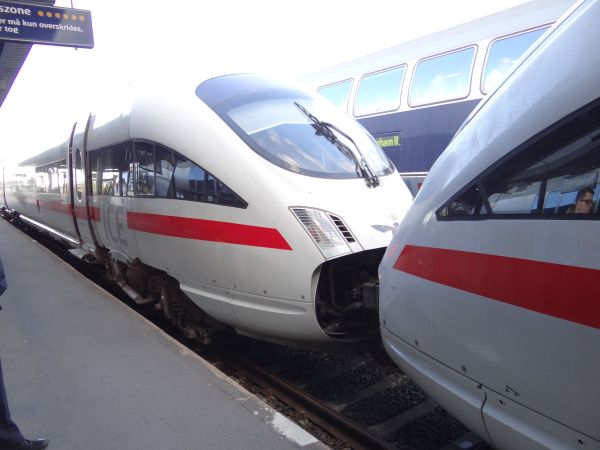
Two ICE-TD trains have just arrived from Copenhagen to Nykøbing (Falster) station. Here they will be unlinked.
One unit remains in Nykøbing while the other one continues to Rødby ferry harbour, is packed on a rail ferry and
will cross the strait to Germany and then continue to Hamburg. In 2016 this habit was broken: The rail+ferry
connection to Hamburg has become so popular that one ICE-TD was not enough and two would not fit on the ferry. But
two units of IC3 rubbernoses just barely fit, so IC3s are yet again replacing the newer ICEs in this traffic.
Picture from Nykøbing (Falster) station 21.9.2014 by Ilkka Siissalo.
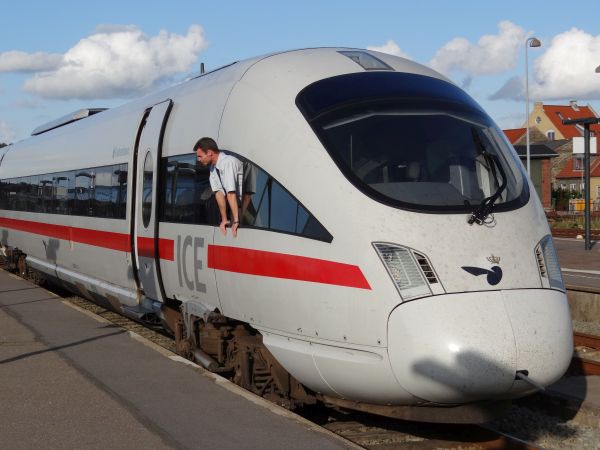
Same two ICE-TD trains as above. The driver is leaning out of his window to see when he gets a signal that the two
units have been successfully uncoupled and he can move his unit forward.
Picture from Nykøbing (Falster) station 21.9.2014 by Ilkka Siissalo.
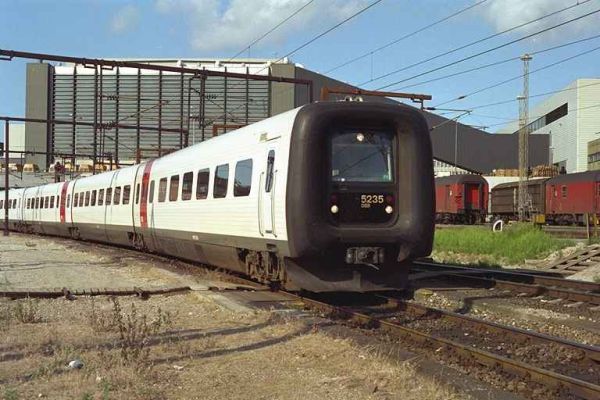
DSB class MF no.5235 articulated multiple unit "IC3". An IC3 train consists always of three coaches, named always MFA, FF and MFB
Photo from Copenhagen Central station on 02 July 1995 by Erik Hjelme.
Uploaded Nov 18, 1995.
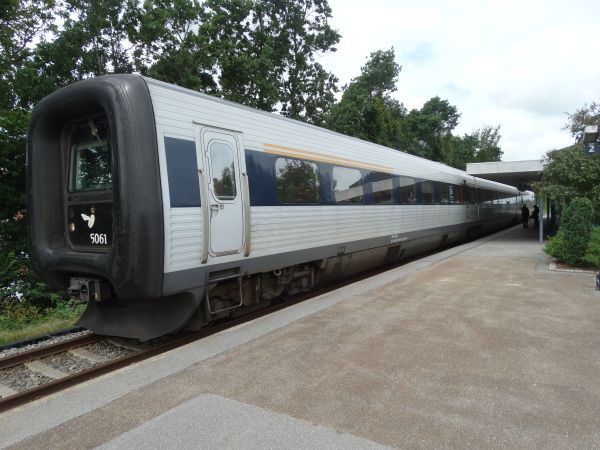
DSB IC3 train (class MFA) as they are today. DSB has exactly similar "rubberface" trains both as diesels
and as electric multiple units, always as 3 coach sets when it comes to diesel. Often they are coupled together
in main line traffic so that part of the IC3 train is diesel and part is electric powered.
Photo from Brønderslev station 7.7.2016 by Ilkka Siissalo.
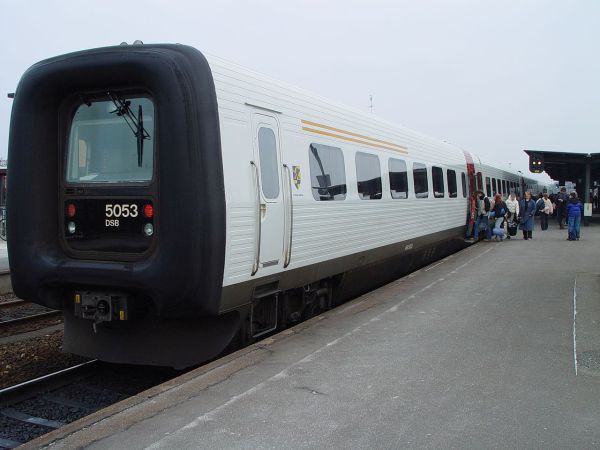
In 2003 IC3 trains were still white with red doors and looked pretty new and fresh.
Picture from Nykøbing station 2.3.2003 by Ilkka Siissalo.
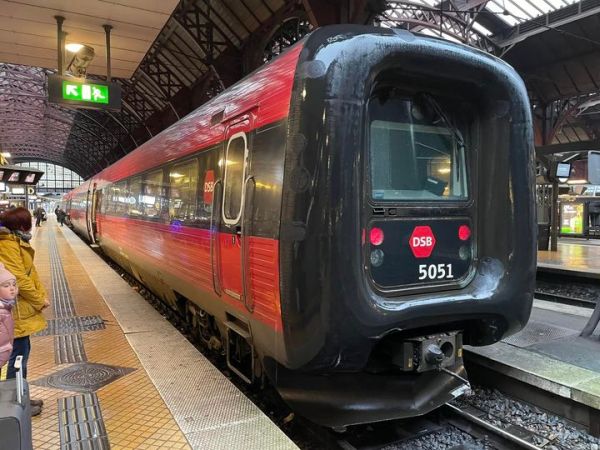
This individual IC3 train was built at ABB Scandia in Randers in 1991. It got a name "Niels Kjeldsen". It was painted
all white, except at the sites where the doors are, there were red stripes going round the whole coach. In October 2016 this train
burned in Odense. It was rebuilt in 2017-18 and then received one new wagon chassis from a similar train bought used from
Sweden to get reserve parts. Then in 2018 this one was painted red and black and at the time of writing this text in 2022 this is one of
just two Danish IC3 trains which are painted in this red livery.
Picture from København C 20.12.2022 by Ben Jones.
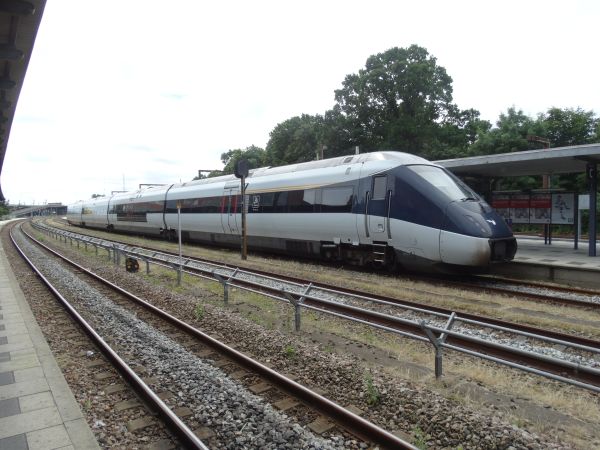
This is the Italian AnsaldoBreda built IC4 train, which has become famous for being too late and so crappy. Years and years
late and now, when they finally are in operation, only about 50% of the fleet can be kept moving. Lawyers are the
only ones who benefit on this.
Picture from Aalborg station 7.7.2016 by Ilkka Siissalo.
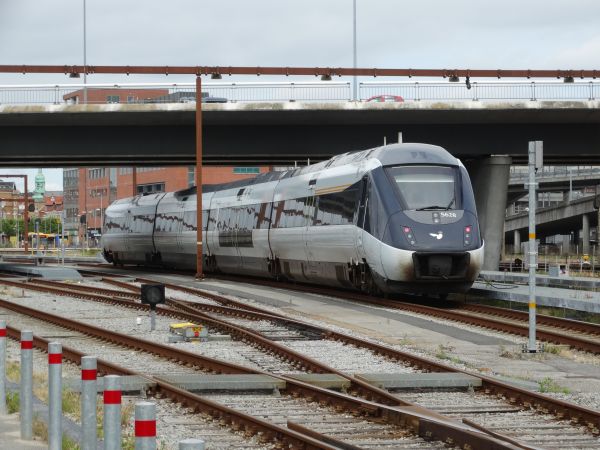
Another view of an IC4.
Picture from Aalborg station 7.7.2016 by Ilkka Siissalo.
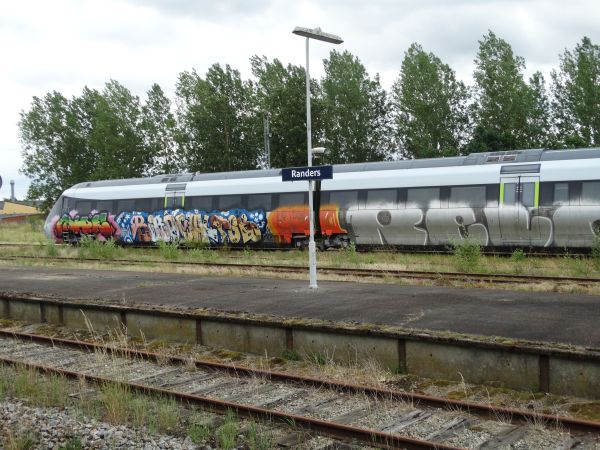
Denmark still has a really bad graffiti problem with trains, and especially as broken trains of the Italian IC4 and IC2
classes often stand still for longer periods, they get awfully badly spoiled by vandals.
Picture from Randers station 7.7.2016 by Ilkka Siissalo.
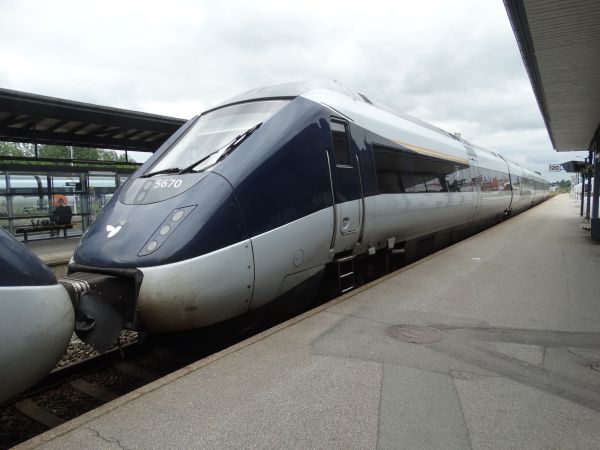
Two Italians kissing - the coupling of two IC4 units. At least these two units are not broken at this moment.
Picture from Randers station 7.7.2016 by Ilkka Siissalo.
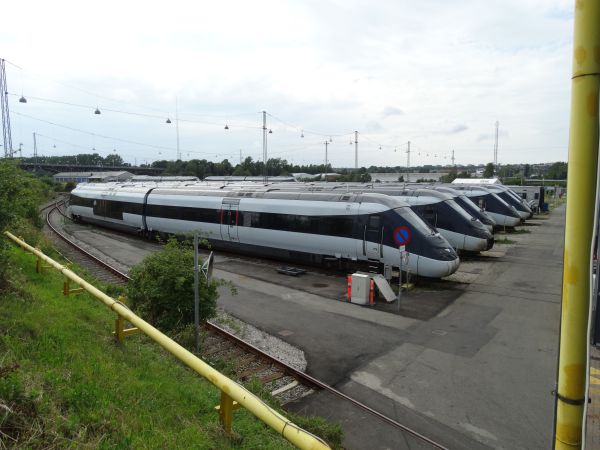
IC2 is the two coach version of the Italian AnsaldoBreda built diesel multiple unit for DSB. Currently they are all out of service and legal action against
the builder is ongoing. DSB sold many of these trains already to Romania and hopes to sell the rest too. But all possible parking places are still full of them,
like here at Aarhus works of DSB. At the time when DSB
gave up trying to use them in the summer of 2016, only seven units were in such a condition that they could move.
Note that several private railroads in Denmark also have units called IC2, which are of the so called "rubberface" type and
have absolutely nothing to do with these Italian fiascos.
Picture from Aarhus 7.7.2016 by Ilkka Siissalo.
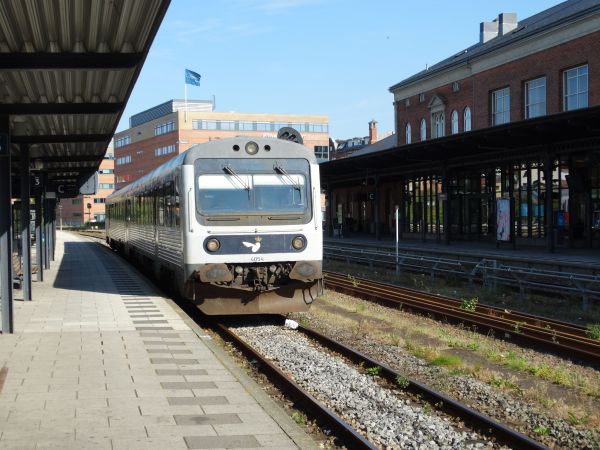
This is the model that the Italian IC2 was supposed to push aside. This is a class MRD lightweight diesel multiple unit
built by Scandia in Randers, based on a German Düwag design from 1983. They have been used most of their life especially
on sidelines on the Jutland peninsula, but they have become rare lately.
Picture from Aalborg station 31.8.2016 by Ilkka Siissalo.
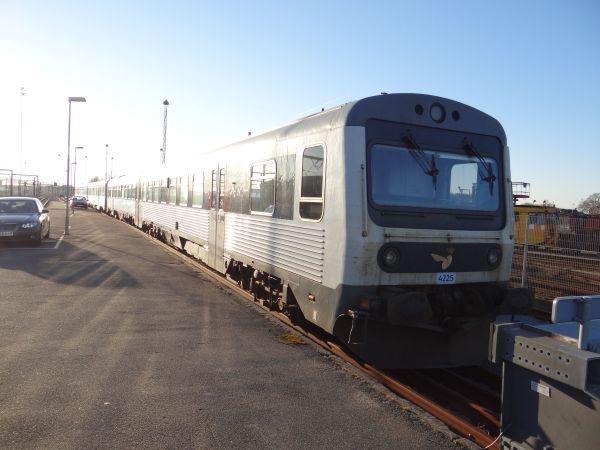
Another picture of the old class MRD. This time two units standing as an operational reserve at Odense station 12.3.2014.
Picture by Ilkka Siissalo.
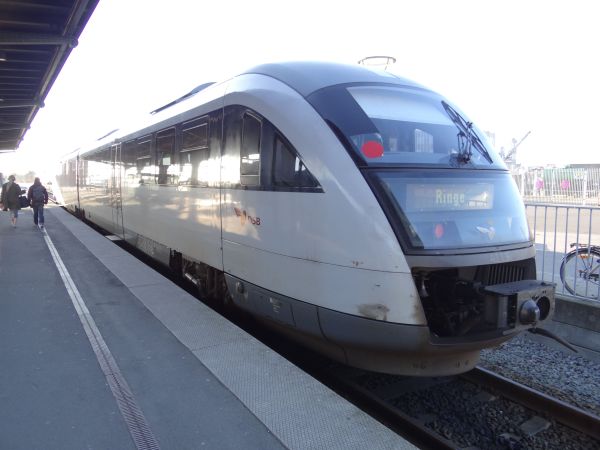
This is a Siemens made Desiro railbus, in Denmark known as class MQ. DSB bought 12 of them in 2002 and a further 8 in 2010.
They also were intended as a replacement for the old MRD shown above.
Photo from Odense station 12.3.2014 by Ilkka Siissalo.

Front view of DSB class MX no.1001 built in 1960 (A1A)'(A1A)' GM 567c-12.
Railway Museums open day at Randers, Denmark 12 August 1995.
Photo by Erik Hjelme.
Uploaded Nov 18, 1995.
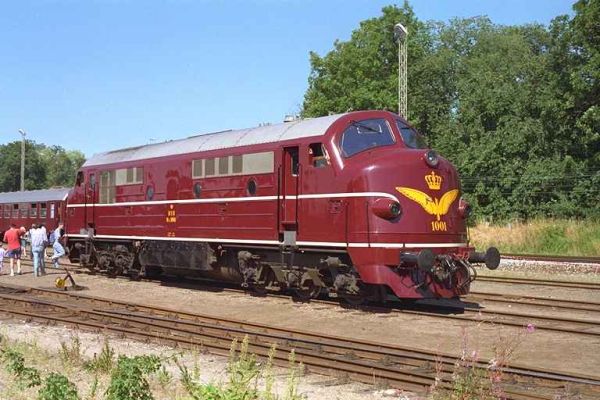
Another view of DSB class MX no.1001.
Railway Museums open day at Randers, Denmark 12 August 1995.
Photo by Erik Hjelme.
Uploaded Nov 18, 1995.
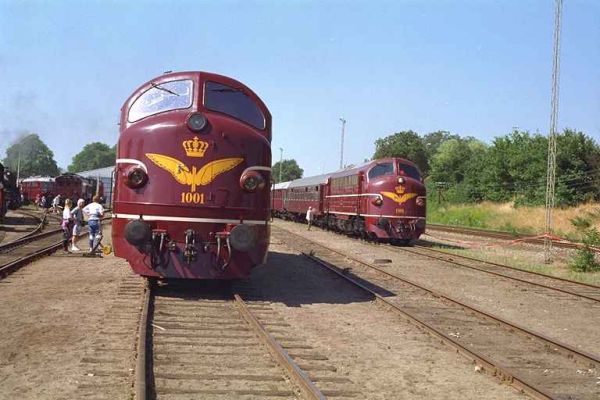
Two different but similar Nohab GM diesels. DSB MX 1001 built in 1960 (A1A)'(A1A)' GM 567c-12.
In the background class MY no.1101. Railway Museums open day at Randers, Denmark 12 August 1995. Photo by
Erik Hjelme.
Uploaded Nov 18, 1995.
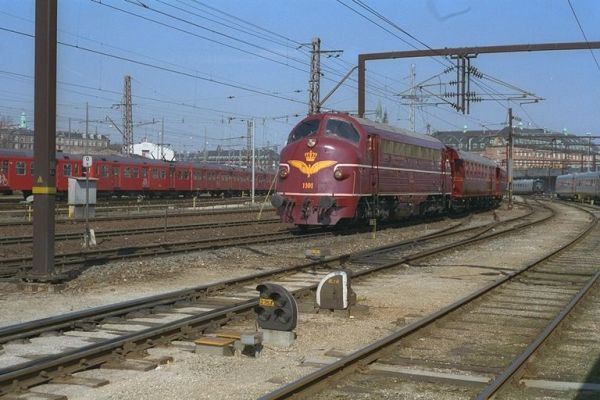
Class MY 1101 leaving Copenhagen on its way to the Railway Museum's annual meeting in Odense.
Photo 8th April 1996 by Erik Hjelme.
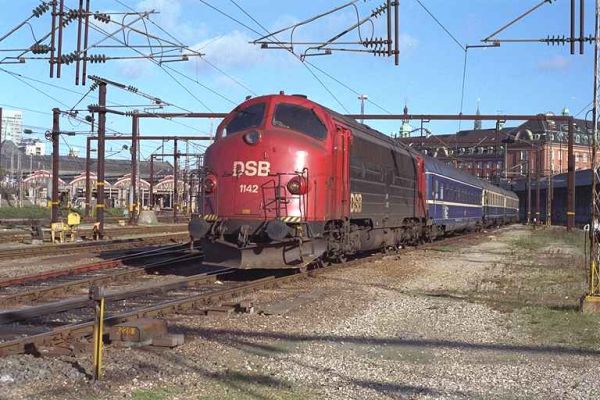
Class DSB MY no. 1142 (A1A)'(A1A)' locomotive GM 567c-16 built in 1958. Photographed at
Copenhagen Central station performing shunting duties because no driver
could be found for the normal yard shunter. Photo on 13th October
1995 by Erik Hjelme.
Uploaded Nov 18, 1995.
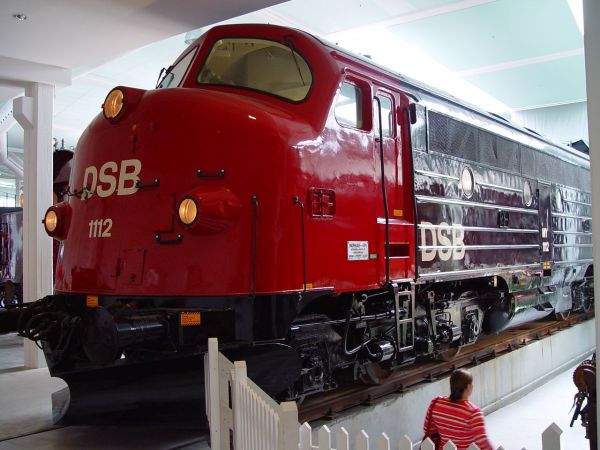
1950s elegance from Sweden, copied from 1930s elegance from USA: A DSB class MY Nohab at the Danish
national railway museum in Odense.
Picture by Ilkka Siissalo 3.7.2004.
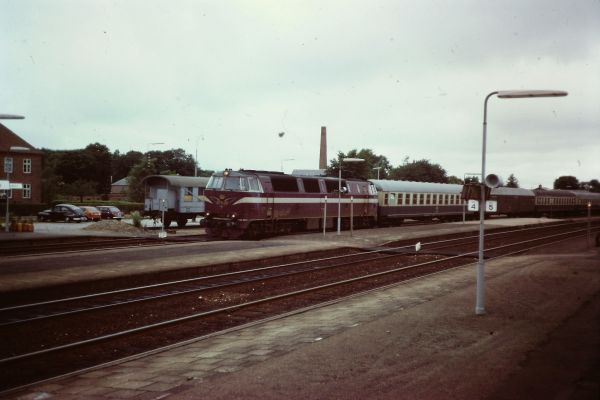
DSB's class MZ diesel taking a German Deutsche Bundesbahn express train into the station of Lunderskov. DSB used to have 61 of these
large locomotives built by the Swedish company Nohab. They had engines built by EMD in USA. These locomotives were built in four series
during 1967 to 1978. The different series are also a bit different, for example the windscreen windows differ. DSB doesn't use these any
more but many old formerly DSB's MZ locomotives are still in use in Norway and Sweden and some are used by DB Cargo in Denmark.
Picture from Lunderskov in 1978 by Adrian Gray.

This is a Köf II, originally a German army design from the wartime. Köf II stands for "Kleinlokomotive,
ölgefeuert, II Generation" or small locomotive, (diesel) oil powered, second generation. The original
idea was that it was easier to move trains in the vicinity of enemy during war time when there was no
cloud of smoke to reveal the engine. Germany, which had invaded Denmark, forced also Danish factories
to build several types of German locomotives and the Danes continued making them after the war. This
one has been built by Frichs in Denmark 1947, but Köf IIs were built in Denmark all the time until 1969.
Picture from the Danish railways museum in Odense 13.3.2014 by Ilkka Siissalo.
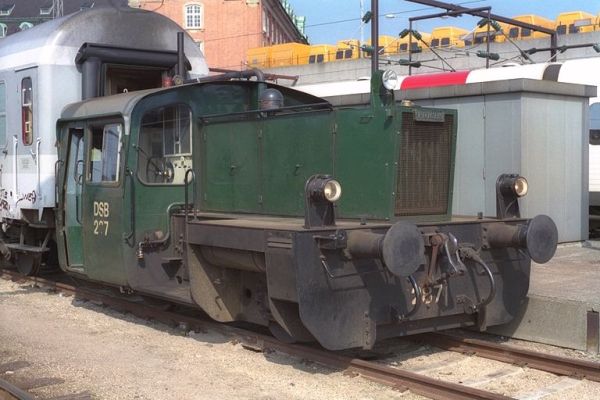
Köf II no.287 diesel-hydraulic switch tractor built in Denmark until 1969,
derived from a wartime German design. Photo from Copenhagen 25 April 1996 by Erik Hjelme.
Uploaded May 20, 1996.
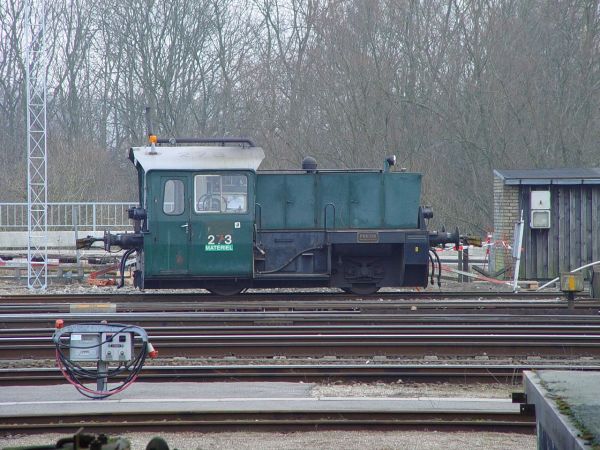
One of the old Köf II diesel tractors was still in 2003 working in its very old green paintings
in Nykøbing (Falster) station as Ilkka Siissalo took this photo on 2.3.2003.
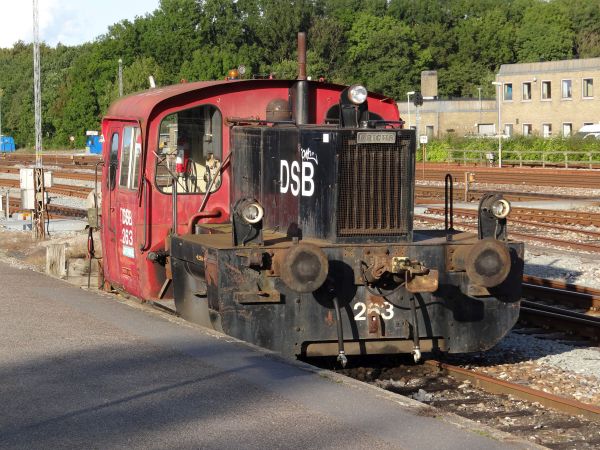
Design from the times of World war II, built in 1966 and still in full use in 2014: One of the old Köf II diesel
tractors, but this time in DSB's red and black paintings. It looks already pretty old and crappy.
Picture from Nykøbing (Falster) station by Ilkka Siissalo 21.9.2014.
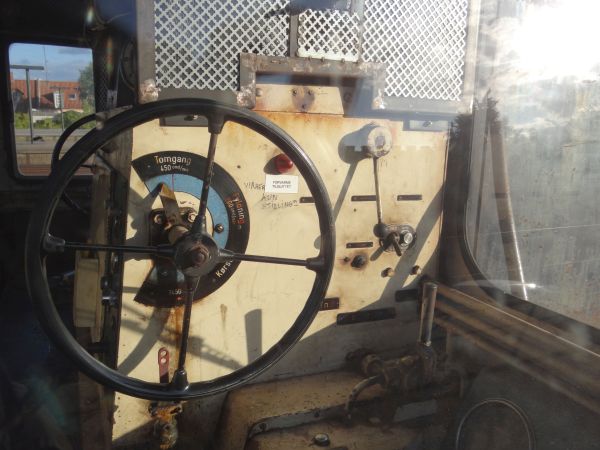
Driver's controls of the same Köf II as above. It's clear that the design is right from the 1930s.
Picture from Nykøbing (Falster) station by Ilkka Siissalo 21.9.2014.
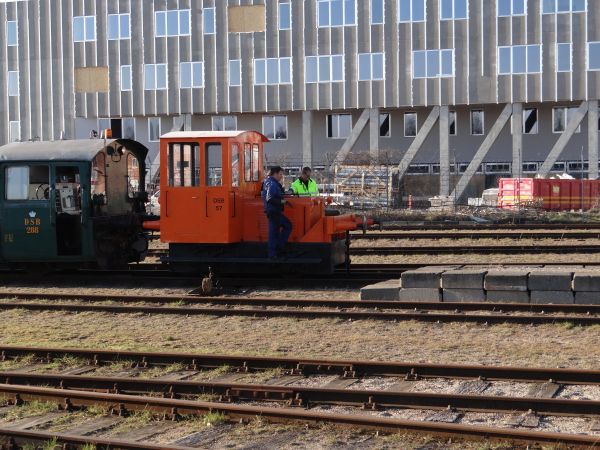
DSB tractor no.57 was built by Pedershåb in 1953. Now it is kept at the national railway museum in Odense.
Picture from Odense 13.3.2014 by Ilkka Siissalo.
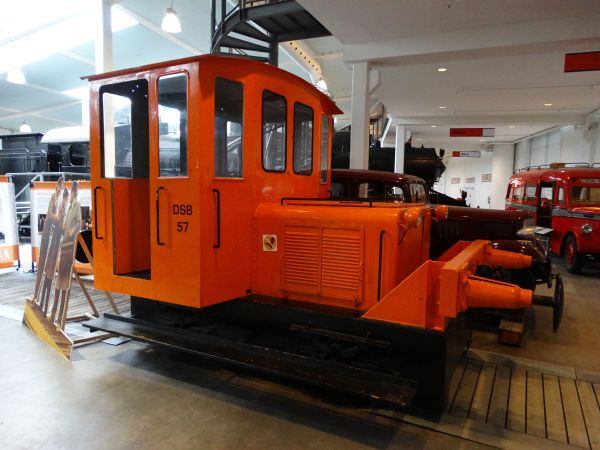
Another picture of the same tractor no.57 from the national railway museum in Odense.
Picture from Odense 10.7.2016 by Ilkka Siissalo.

Class MH no. 407 was a dieselhydraulic shunter locomotive built in Denmark 1960 to 1965
derived from a German design. These machines are now all scrapped, except for some museum units. Photo from Copenhagen
25 April 1996 by Erik Hjelme.
Uploaded May 20, 1996.
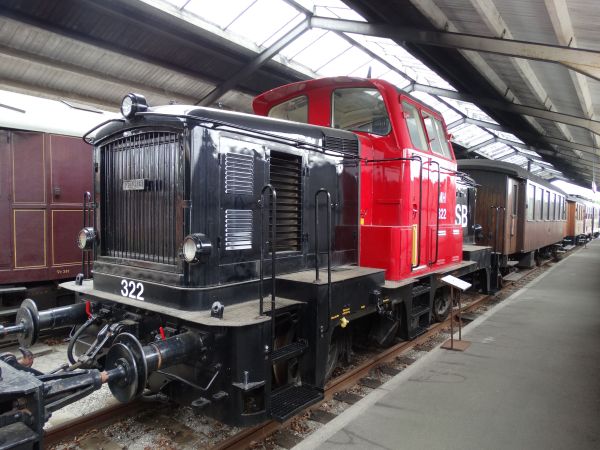
The last remaining class MH locomotives are now in museum.
Picture from the Danish railway museum in Odense 10.7.2016
by Ilkka Siissalo.
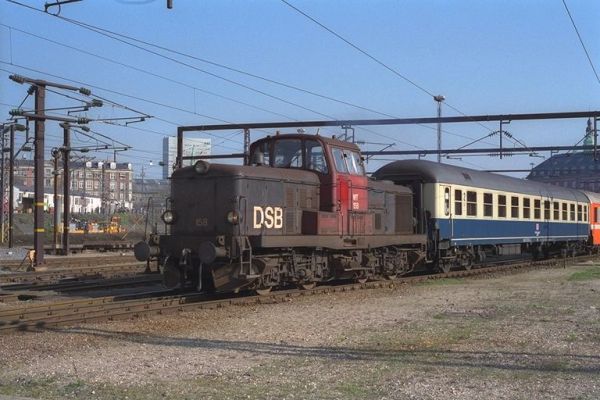
Class MT no. 158, a diesel-electric Bo'Bo' locomotive built 1958 to 1960, performing
switch duties. It could also be used for light duties on the then large network of branch
lines. Photo from Copenhagen 25 April 1996 by Erik Hjelme.
Uploaded May 20, 1996.
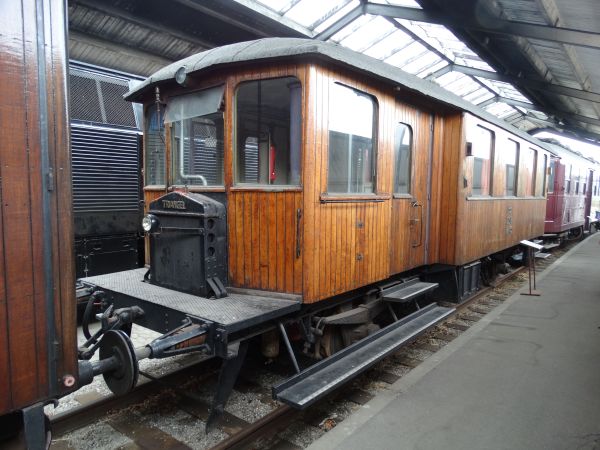
The class ME railbuses (not to be confused with a later class ME big diesel engine, shown on this page above) built by
Triangle in 1927-28 were the first motor railbuses of Denmark. They soon became too small and were too heavy
for their little payload, but were still an important improvement over smoky steam engines.
Picture from the Danish railway museum in Odense 10.7.2016 by Ilkka Siissalo.
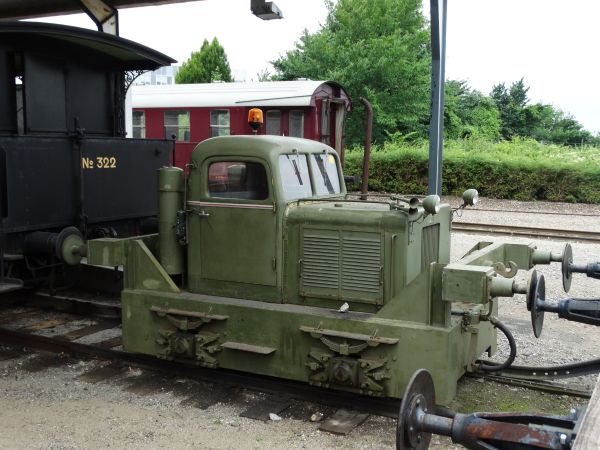
When Nazi Germany invaded Denmark, the Germans built a new air force base at Skrydstrup and also a rail connection to the
airfield. After the war Danish air force took over. They used this tractor "P.M. Motor-Lokomotiv" no.459 built by Pedershåb
in 1954 for moving of wagons between the air base and the nearest station.
Picture from the Danish national railway museum in Odense 10.7.2016 by Ilkka Siissalo.
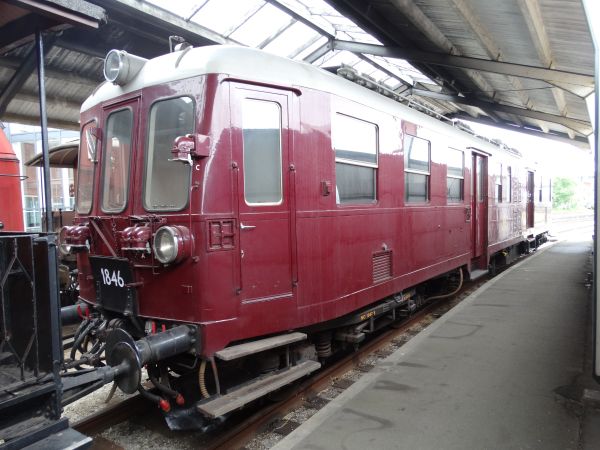
This DSB class MO diesel railbus was built by Frichs in Århus in 1954. Built from the 1930s till 1958 the class MO was very
common on side lines throughout the country and at one point of time they were the most common trains of the country and were
used even in express trains. Seven units have survived until today.
Picture of MO 1846 at the Danish national railway museum in Odense 10.7.2016 by Ilkka Siissalo.

